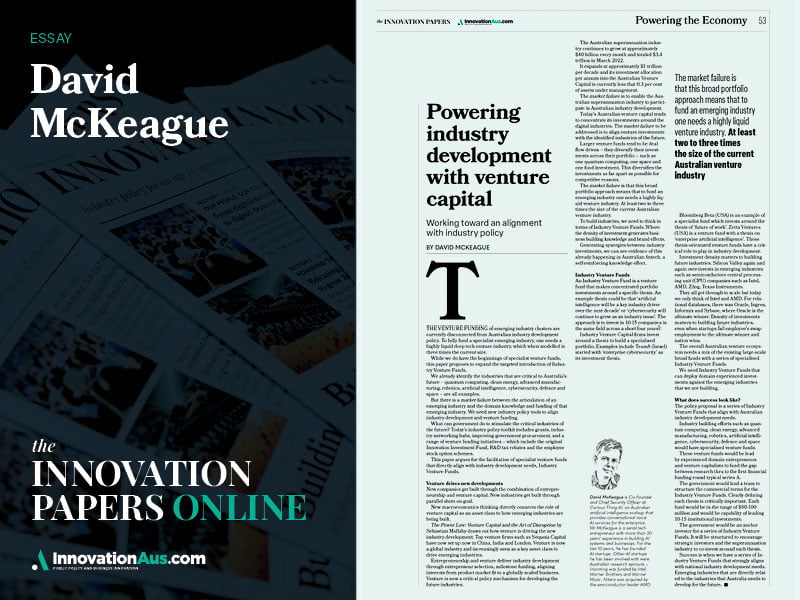The venture funding of emerging industry clusters are currently disconnected from Australian industry development policy. To fully fund a specialist emerging industry, one needs a highly liquid deep tech venture industry, which when modelled is three times the current size.
While we do have the beginnings of specialist venture funds, this paper proposes to expand the targeted introduction of Industry Venture Funds.
We already identify the industries that are critical to Australia’s future – quantum computing, clean energy, advanced manufacturing, robotics, artificial intelligence, cybersecurity, defence and space – are all examples.

But there is a market failure between the articulation of an emerging industry and the domain knowledge and funding of that emerging industry. We need new industry policy tools to align industry development and venture funding.
What can government do to stimulate the critical industries of the future? Today’s industry policy toolkit includes grants, industry networking hubs, improving government procurement, and a range of venture funding initiatives – which include the original Innovation Investment Fund, R&D tax rebates and the employee stock option schemes.
This paper argues for the facilitation of specialist venture funds that directly align with industry development needs, Industry Venture Funds.
Venture drives new developments
New companies get built through the combination of entrepreneurship and venture capital. New industries get built through parallel shots on goal.
New macroeconomics thinking directly connects the role of venture capital as an asset class to how emerging industries are being built.
The Power Law: Venture Capital and the Art of Disruption by Sebastian Mallaby draws out how venture is driving the new industry development. Top venture firms such as Sequoia Capital have now set up now in China, India and London. Venture is now a global industry and increasingly seen as a key asset class to drive emerging industries.
Entrepreneurship and venture deliver industry development through entrepreneur selection, milestone funding, aligning interests from product market fit to a globally scaled business. Venture is now a critical policy mechanism for developing the future industries.
The Australian superannuation industry continues to grow at approximately $40 billion every month and totalled $3.4 trillion in March 2022.
It expands at approximately $1 trillion per decade and its investment allocation per annum into the Australian Venture Capital is currently less that 0.3 per cent of assets under management.
The market failure is to enable the Australian superannuation industry to participate in Australian industry development.
Today’s Australian venture capital tends to concentrate its investments around the digital industries. The market failure to be addressed is to align venture investments with the identified industries of the future.
Larger venture funds tend to be deal flow driven – they diversify their investments across their portfolio – such as one quantum computing, one space and one food investment. This diversifies the investments as far apart as possible for competitive reasons.
The market failure is that this broad portfolio approach means that to fund an emerging industry one needs a highly liquid venture industry. At least two to three times the size of the current Australian venture industry.
To build industries, we need to think in terms of Industry Venture Funds. Where the density of investment generates business building knowledge and brand effects.
Generating synergies between industry investments, we can see evidence of this already happening in Australian fintech, a self-reinforcing knowledge effect.
Industry Venture Funds
An Industry Venture Fund is a venture fund that makes concentrated portfolio investments around a specific thesis. An example thesis could be that ‘artificial intelligence will be a key industry driver over the next decade’ or ‘cybersecurity will continue to grow as an industry issue’. The approach is to invest in 10-15 companies in the same field across a short four years?.
Industry Venture Capital firms invest around a thesis to build a specialised portfolio. Examples include Team8 (Israel) started with ‘enterprise cybersecurity’ as its investment thesis.
Bloomberg Beta (USA) is an example of a specialist fund which invests around the thesis of ‘future of work’. Zetta Ventures (USA) is a venture fund with a thesis on ‘enterprise artificial intelligence’. These thesis-orientated venture funds have a critical role to play in industry development.
Investment density matters to building future industries. Silicon Valley again and again over-invests in emerging industries such as semiconductors central processing unit (CPU) companies such as Intel, AMD, Zilog, Texas Instruments.
They all got through to scale but today we only think of Intel and AMD. For relational databases, there was Oracle, Ingres, Informix and Sybase, where Oracle is the ultimate winner. Density of investments matters to building future industries, even when startups fail employee’s swap employment to the ultimate winner and nation wins.
The overall Australian venture ecosystem needs a mix of the existing large-scale broad funds with a series of specialised Industry Venture Funds.
We need Industry Venture Funds that can deploy domain experienced investments against the emerging industries that we are building.
What does success look like?
The policy proposal is a series of Industry Venture Funds that align with Australian industry development needs.
Industry building efforts such as quantum computing, clean energy, advanced manufacturing, robotics, artificial intelligence, cybersecurity, defence and space would have specialised venture funds.
These venture funds would be lead by experienced domain entrepreneurs and venture capitalists to fund the gap between research thru to the first financial funding round typical series A.
The government would lead a team to structure the commercial terms for the Industry Venture Funds. Clearly defining each thesis is critically important. Each fund would be in the range of $80-100 million and would be capability of leading 10-15 institutional investments.
The government would be an anchor investor for a series of Industry Venture Funds. It will be structured to encourage strategic investors and the superannuation industry to co-invest around each thesis.
Success is when we have a series of Industry Venture Funds that strongly aligns with national industry development needs. Emerging industries that are directly related to the industries that Australia needs to develop for the future.
David McKeague is Co-Founder and Chief Security Officer at Curious Thing AI, an Australian artificial intelligence scaleup that provides conversational voice AI services for the enterprise. Mr McKeague is a serial tech entrepreneur with more than 30 years’ experience in building AI systems and businesses. For the last 10 years, he has founded AI startups. Other AI startups he has been involved with were Australian research spinouts – Incoming was funded by Intel, Warner Brothers and Warner Music. Nitero was acquired by the semiconductor leader AMD.
Do you know more? Contact James Riley via Email.


Dave, VC isn’t philanthropy mate. They aren’t do-gooders. Whose money do you think they have? They don’t “fund” stuff. This isn’t a give-to-the-needy thing. They want the money back – with 20% profit. If your wonderful, amazing, genius innovation is going to lose their money (bye-bye money, forever) they won’t be interested. You say there’s a market failure. Your answer is the APS writing a new policy? Mate, wake up and smell the coffee. Have you ever met the APS? They have any idea how new companies get built? No. The bureaucrats could structure the commercial terms for an Industry Venture Fund? No. The state would be an equity investor? No Dave. Capitalism creates capital, it doesn’t burn it. You want the Australian superannuation industry to lose your super? “Sorry Dave, that moon-shot went tits-up, now your retirement is on the dole.” You ask, what does success look like? It looks like Dave retiring with his nest-egg in a house at Byron Bay. You really want to get your hands on the Future Fund in Melbourne, but its purpose is to pay APS superannuation. (ps. Good to see the MBA mate, and you can understand a Balance Sheet. The APS won’t. It doesn’t have an MBA. Its money is “funding” and is like Christmas. It happens every year, regardless. Look deeper.)